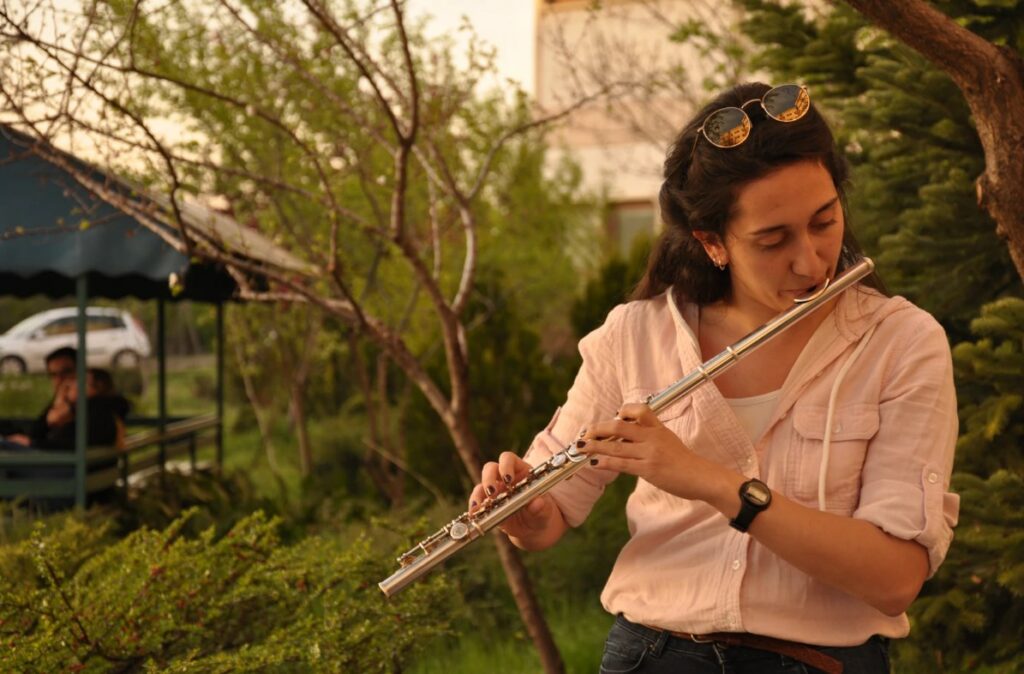- Top Trumpet Embouchure Techniques: Options for Beginners Through Professionals - October 12, 2022
- Is the Trumpet Hard to Learn? - September 30, 2022
- Best Leblanc Clarinet Models Guide: From Soprano to Contrabass - September 5, 2022
Even non-musicians have heard of the flute and the piccolo. But not a lot of people know much, if anything, about the alto flute. If you’re a flutist and want to expand your skills, you should know how to find the best alto flute.
A good alto flute can open up a lot of doors when it comes to repertoire and performance opportunities, both as a professional and amateur. Want to take your flute playing to the next level? Learn how the right alto flute can help!
What is the Alto Flute?
The alto flute is a member of the concert flute family, and it’s pitched in G, meaning it plays a fourth below the concert flute. But it reads the same notes as the concert flute when you look at sheet music. The fingerings are the same for the same written notes.
In most cases, players don’t have to worry about this difference; composers will write the alto flute part correctly. But you may need to transpose music if you want to play music for the C flute on your alto flute.
Alto flutes have a similar design to concert flutes, but they’re longer and have a bigger tube circumference. That allows you to play lower pitches.
The alto flute is super fun to play, but you need a good-quality instrument. That way, you won’t have to deal with a ton of issues during a rehearsal or performance.
An Overview of Alto Flute Specs
Before you determine how to find the best alto flute for you, you should understand the most common specs. The alto flute shares a lot of these with other flutes, but there are some differences.
Straight Vs. Curved Headjoint
When you look at a concert flute, you’ll see that it has a straight headjoint, so the whole instrument is in one line. Many alto flutes have this same design, but not all of them.
Some flute players prefer to use a curved headjoint when playing the alto flute. This gives the flute a J shape, and it brings the keys closer to the player, so they’re easier to reach.
Curved headjoints are great for players with small hands and/or short arms. They’re also useful for players who have arthritis or other joint issues.
However, you don’t need to be tall to use a straight headjoint comfortably. I’m about 5′ 3″, and I can use a straight alto flute headjoint without a ton of issues.
Ergonomic Left Hand
Whether you select an alto flute with a straight or a curved headjoint, you may want to look for one with an ergonomic left-hand design. These alto flutes use keys and rods to bring the left hand closer to the player.
Instead of pressing the left-hand keys directly, the rods trigger those keys to open and close. If you get an alto flute that doesn’t have this special design, you might have trouble reaching the keys with a straight headjoint.
Players with long arms may be able to play that type of alto flute. However, many alto flutes use an ergonomic design, but some older alto flutes on the used market may not have that feature.
C Footjoint Vs B Footjoint
The first alto flute spec that also applies to the concert flute is on the footjoint. Most alto flutes have a C footjoint, so the lowest note they can play is a written C (though it sounds like a G).
However, some more expensive alto flutes have a low B key, so you can play a half-note lower (sounding F#). Having this extra key can be useful when playing music written in the past few years.
Because that key is standard on many flutes, some composers may not know it’s not as common on the alto flute. But you don’t need this lower key to be able to play a lot of music on the instrument.
Split E
Another flute spec that you can find on the alto flute is the split E mechanism. This splits the keys that open when you play the third octave E (see picture).
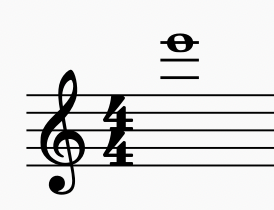
Having a split E mechanism can make it easier to play that note without it cracking or having other issues. However, you don’t need to have it for an alto flute to be the best for you.
If you don’t have this spec, you can work on that note to figure out how to play it well. Then, you can know how to form your lips and what to do with your air for it to come out.
Open Holes
Open holes are very rare on alto flutes, but they do exist. The Dutch alto flute maker Eva Kingma makes a few alto flutes with open holes, and they’re usually on the right-hand keys.
You can also get an open-hole alto flute from the brand Kotato. Having open holes on any flute allows you to play certain extended techniques, such as quarter tones, which are pitches between two regular notes.
Most alto flute players don’t need an open hole model, but it’s worth knowing they exist. If you decide to take your alto flute playing seriously, you may want to upgrade to one of these models in the future.
Materials
Another thing to consider when choosing an alto flute is the materials. Because the alto flute is already heavy, many of them use a nickel base with silver plating to cut down on excess weight.
However, you can find plenty of full solid silver alto flutes. A couple of makers, including Gemeinhardt and Trevor James, make nickel-plated alto flutes, which are great for players with silver allergies.
Trevor James also makes an alto flute using a copper alloy, which combines copper with silver and some other materials. And Yamaha makes an excellent alto flute using brass.
Most people will start on a silver-plated alto flute, and that’s what I currently play. The plating gives some elements of the sound of silver, but it doesn’t weigh as much as it could.
How to Find the Best Alto Flute
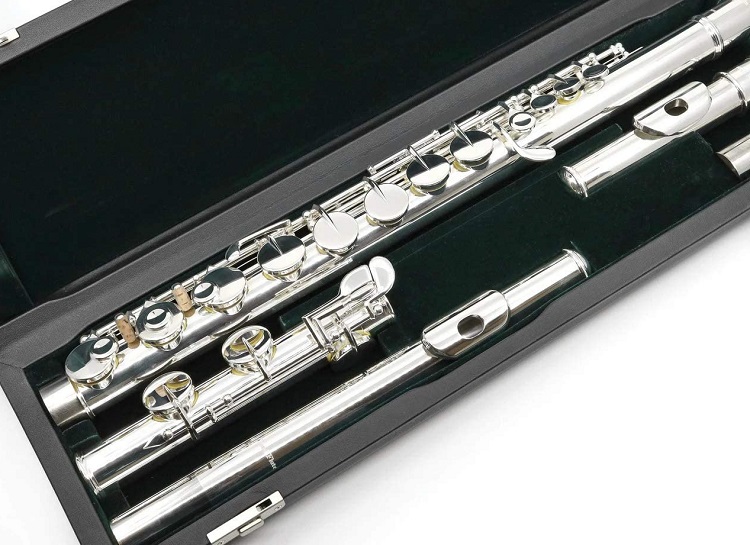
Knowing how to find the best alto flute for you is crucial to getting a good start on the instrument. While many people first learn on an alto flute from school or a community group (myself included), more players are buying their own altos.
Alto flutes don’t have the same standardization as concert flutes when it comes to key layout and other design factors. That means that what works for one player may not work for you.
Be sure to follow a few steps to help find the best alto flute to help you learn and enjoy playing it.
Know what Specs You Want
Before you go shopping for an alto flute, you should consider if there are any specs you need or want. The biggest factors to consider are the headjoint and the left-hand key layout.
If you have short arms and get an alto flute with a straight headjoint and no ergonomic left hand, you may struggle. Then, you could end up feeling uncomfortable or even in pain.
Musicians are already prone to repetitive stress injuries from playing so much. And the alto flute requires you to position your hands and arms off to the center.
Consider Your Budget
Some alto flutes can cost close to $15,000, but others are about one-tenth of that. However, the big price range means you need to know how much you can or are willing to spend on an alto flute.
If you want to get a new alto flute, you should set aside at least $2,000 so that you have some wiggle room to find a good model. When you’re looking to upgrade to a better model, you may want to have $3,000 to $4,000 ready to go.
You can also look into the used market to find an alto flute for less money. Some used alto flutes haven’t been played much and are in good condition, but they don’t cost quite as much.
Try as Many Altos as You Can
As I mentioned, alto flutes can feel very different, especially when you’re looking at different brands. Try at least two to three alto flutes, if not more, before you buy one.
Make sure the alto flute you choose feels comfortable to hold for you. While you can ask others for their opinions, no one else can tell you what will work best for you.
The easiest way to try a ton of alto flutes is to go to a store or contact a store for an in-home trial. They can send you a few alto flutes at a time so that you can compare them.
When trying alto flutes, use the same exercises or music to keep as many trial elements the same. Use a piece of paper or your notes app to write out any thoughts you have about the instruments, especially if you try them at separate times.
Compare Multiple Flutes
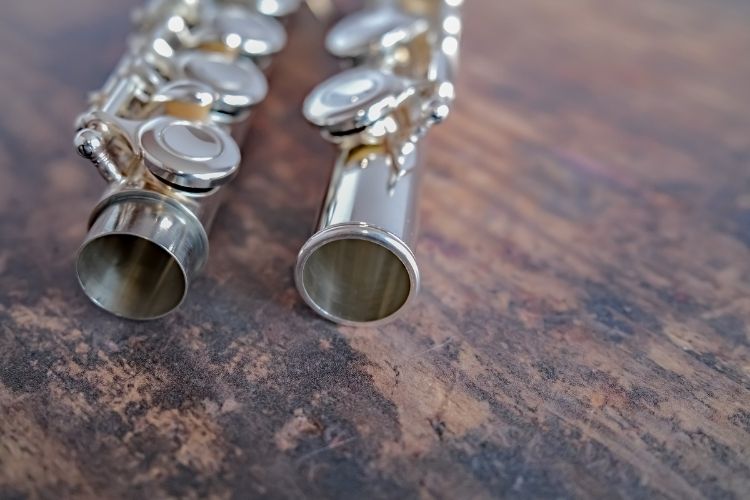
In some cases, you may find the perfect alto flute on your first try. However, you should still try other models to compare them and to verify that you’re choosing the best one for you.
If you try a lot of alto flutes, make a note of the ones you like the most. And if you find that you don’t like one, stop testing it and move on to a different model.
Really listen to how the notes sound and feel your fingers move. Notice if you feel in pain or another form of discomfort. Consider how easy it is to move your fingers and how much air you need to get a good sound.
Test the Range
During your alto flute trial, make sure you play as high and low as possible. An easy way to do this is to play a chromatic scale from the bottom to the top of the range and back down.
As you play each note, listen to the quality of the sound. Use a tuner to see if the notes are in tune and what the problematic notes are.
If all of the notes are off in the same direction, adjust the headjoint. You can pull it out slightly to lower the pitch or push it in to raise the pitch. Then, see if you’re still having problems with the tuning, and if so, it’s not a good alto flute.
Listen to Your Body
Throughout your entire alto flute trial process, listen to your body. If you feel like you have to strain yourself to reach the keys, stop playing. And if you just feel in pain, you should put the alto flute down.
Take a break if necessary and remember which alto flutes are causing the most issues. Remove those alto flutes from your trial rotation because the pain isn’t worth it, even if it’s in your budget and has the specs you want.
Feel free to stretch before, during, and after an alto flute playing session. Stretch out your arms and fingers so that they’re able to move more easily, but don’t force anything.
Get a Second Opinion
Once you find an alto flute that sounds good and is comfortable to play, consider having someone else listen to you. If you have a flute teacher, you can ask them. You can also ask another flute player you know or even a non-musician.
Ask the person to listen to you play different pieces of music or different notes. If you’re trying to decide between two alto flutes, have the second person compare the two.
They can also help you do a blind playing test, especially if both use the same headjoint style. You can put on a blindfold and play to see which you like better. That way, you won’t have to let your assumptions about brands or pricing affect your decision.
The Best Alto Flutes
Now that you know how to find the best alto flute, you should consider some excellent models. There are tons of alto flutes on the market, probably more than you’d expect.
To help narrow your search, consider the following alto flutes. If you like them, you can find other models from the same brands, and if not, you can look at other companies to find your perfect alto flute.
Pearl PFA201
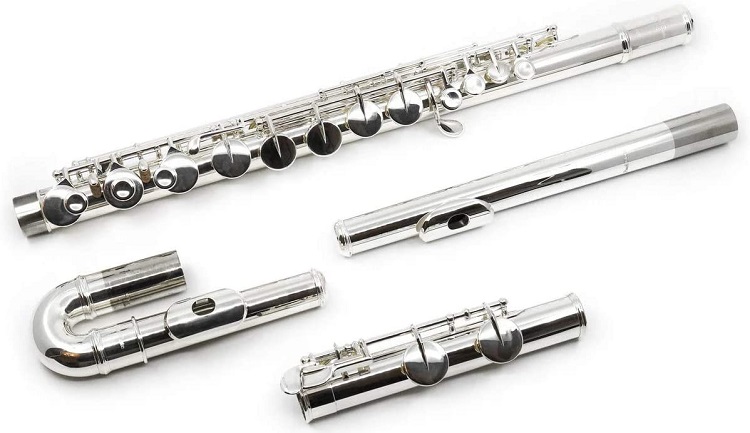
I may be biased, but I’m going to start with my personal alto flute. I’ve played a Pearl PFA201S since the spring of 2018. It’s the entry-level alto flute from Pearl, and it’s a great option.
My personal model is the 201S, meaning that it has a straight headjoint. You can also find a 201U with a curved headjoint or a 201SU, which has both headjoints.
Pearl alto flutes are affordable, so they’re a great option if you aren’t sure if you’ll play the alto flute much. The alto flute has an ergonomic left-hand design, so the keys are easy to reach.
Pros
- Great design
- Good quality
- Affordable
Cons
- Lowest notes can be out of tune
Trevor James Copper Alloy Alto Flute

Another excellent model to try is the Trevor James Copper Alloy Alto Flute. This alto flute uses a mix of copper and silver, so it has a unique look and sound.
While I haven’t played this specific model, I have played a silver-plated alto flute from Trevor James. Their altos are fantastic instruments, and they’re popular among students and professionals.
The Trevor James alto is a bit more expensive than a Pearl, but it’s great quality. Whether you choose the copper alloy, the silver-plated, or the nickel-plated model, you will probably love it.
Pros
- Great quality
- Comfortable key design
- Warm sound
Cons
- A little expensive for casual players
Jupiter JAF1000
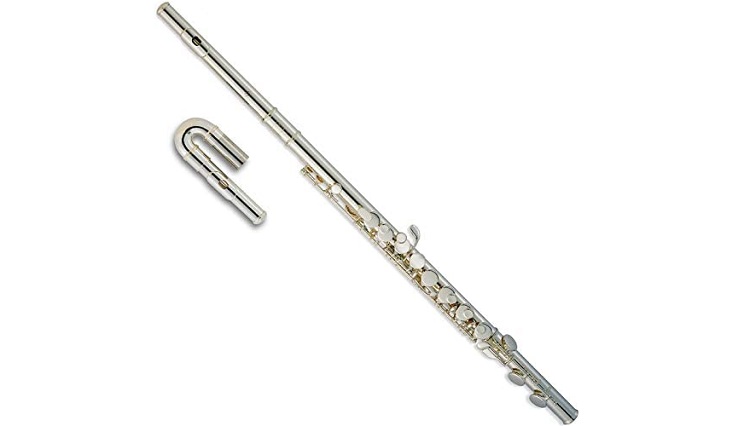
The Jupiter JAF1000 is another great alto flute for beginners and more advanced players. This was one of the first alto flutes I ever played when I borrowed it from my college’s flute studio.
It has a pretty good sound, and it’s comfortable to play. The instrument comes with both straight and curved headjoints, so it’s great for sharing with other players who may have different preferences than you.
While Jupiter isn’t the best-known brand for flutes, the model isn’t too expensive. It’s not the cheapest option, but it can last a long time.
Pros
- Good sound
- Decent quality
- Lasts a long time
Cons
- Not the most affordable
Yamaha Alto 421
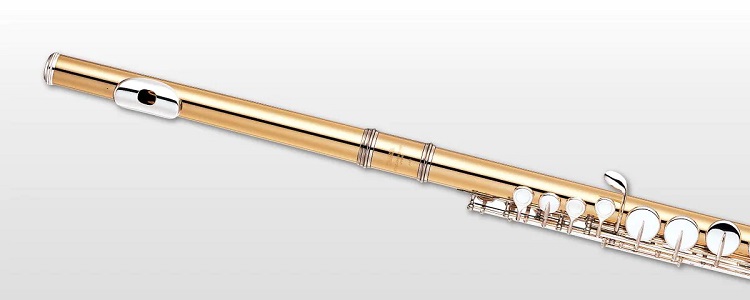
If you’re looking for an alto flute that will last for a long time and you have more money to spend, check out the Yamaha Alto 421. It features a brass alloy with a silver-plated mechanism, so it looks and sounds different from other altos.
Along with the Jupiter, this was the alto flute that my college owned. I got to play it in a flute choir and on my own a few times, and it comes with both a straight and a curved headjoint.
Now, it’s quite a bit more expensive than other altos, with a price tag of over $7,000. However, the price can be worth it for serious players who want a different sound.
Pros
- Unique sound
- Great look
- Good design
Cons
- Very expensive
FAQs about How to Find the Best Alto Flute
Answer: If you aren’t ready to commit to buying one but you need an alto flute, you can rent one. Not many places offer rentals, but the Flute Center of New York does.
You can rent an alto flute for the month, so you can play it for a gig or see if it’s something you want to buy and learn.
Answer: New alto flutes are great, and you can try more of them to find the best alto flute for you. However, they can be expensive, and you may need to settle on a different model than what you want.
If you’re willing to wait and shop around, you can save money on a used alto flute. You’ll have to wait for someone to sell theirs, and you may not be able to try it before you buy it, though.
Answer: Objectively, a straight headjoint offers a better sound and intonation than a curved headjoint. Curved headjoints don’t have the same ability to taper consistently, so they can make more notes hard to play in tune.
But the best headjoint for you is one that’s comfortable. Some people find the curved headjoint makes it easier to reach the keys. I have had a hard time balancing a curved headjoint alto flute when I’ve played them before.
Answer: The alto flute is common in flute choirs, where it serves a similar role to the viola in an orchestra. You can also hear it in certain orchestral works, such as The Planets by Gustav Holst. Some orchestral parts call the alto the “bass flute in G.”
There’s also a growing number of solos for the alto flute, and it’s in some chamber music outside of the flute choir. And if you can transpose, you can use your alto flute in place of the concert flute.
Answer: Most flute players are used to the flute, and even the piccolo, which plays in the key of C (concert pitch). That means the notes you see on paper are what you hear, but the alto flute sounds a fourth lower than written.
Luckily, you don’t have to know how to transpose to play the alto flute. Most composers will transpose the part for you, but I have seen some parts online that don’t. If you need to tune with a piano, all you need to know is that a sounding A is a D on the alto flute.
Answer: The alto flute can be hard to play, especially if you don’t know how to find the best alto flute for you. If you have to struggle to reach the keys, you won’t get very far.
You also need to have good air support to keep the notes in tune and to get enough air through the thicker, longer tube. As long as you practice regularly, you shouldn’t have many problems.
Answer: Many people who play the alto flute started on the C flute beforehand. The C flute is smaller and is a bit easier to get a sound on for beginners.
However, that doesn’t mean you can’t start on the alto flute. If you have access to one and are willing to practice, give it a try.
Final Note on How to Find the Best Alto Flute
Whether you’ve played the flute for years or not, you may want to explore the flute family. When it comes to going low, you need to know how to find the best alto flute.
That way, you can start learning the bigger flute, and you won’t have to deal with tuning or other issues. Instead, you can focus on playing music on your own or in a group.


